tl;dr
- Feedback management tools are specialized software designed for gathering, tracking, and analyzing feedback from various stakeholders, crucial for integrating customer insights into business decisions.
- There are several methods, such as microsurveys, interviews, usability testing, analytics, and online reviews, each suitable for different types of insights (quantitative vs. qualitative) and contexts (e.g., product development vs. customer satisfaction).
- The systematic customer feedback program involves collecting insights and managing feedback from various touchpoints, organizing and sorting the data, analyzing the collected information, and planning the next steps. This is vital for identifying trends, addressing concerns, and fostering product innovation.
- The feedback management tools should support real-time and AI-powered data analysis, multi-channel feedback collection, integration of different feedback sources, automated workflows, and data visualization with custom reporting to enhance user feedback management and drive improvements.
- Successful feedback management requires effective planning, seamless system integration, comprehensive training, and the right strategies to avoid common pitfalls like ignoring negative reviews or over-surveying users.
Understanding and responding to customer feedback is just the beginning. If you really aspire to build products addressing customer needs, you need to find a way to drive your roadmap with it.
Leveraging insights can be tricky, especially since they are usually scattered across different sources. Combining customer feedback into one tool might make it easier for you to categorize and prioritize insights.
As you know, prioritizing features that are most important for your customers may significantly improve user satisfaction and the overall customer experience.
This article delves into feedback management tools, offering guidance on collecting feedback, understanding its importance, and exploring the features that make these tools essential for any customer-focused strategy.

What is a feedback management tool?
A feedback management tool is specialized software designed to gather, track, and analyze feedback from various stakeholders. It helps you understand customers' opinions and incorporate their insights into your business decisions. A good feedback management tool can help you with the following:
- Capturing feedback from various touchpoints
- Organizing and sorting the data
- Integrating feedback from different sources
- Analyzing the collected information
- Suggesting how to act on the insights to make informed improvements
How to collect customer feedback?
To effectively collect and manage feedback about customer satisfaction and experiences, you'll need to identify the right audience and channels.
Make sure to apply the right targeting and methods that will get you contextual insights. Asking the most valuable user group for their opinions will let you ensure that you're moving your product in the right direction.
There are several methods at your disposal:
1. Surveys
Surveys and questionnaires are structured tools for collecting quantitative and qualitative data. They can be distributed through email, social media, or embedded within your product. Ensure questions are relevant and concise to maximize response rates. Some of the types of surveys you can use include:
- Email surveys
- In-product and in-app surveys
- Recurring NPS, CSAT, CES surveys
Here's an example of an NPS survey:
2. Interviews
Interviews require a bit more time but enable you to ask users more detailed and specific questions. It's extremely useful if you want to discuss specific use cases or the need for new features. If you want to manage feedback from user interviews, pay attention if your software offers a text-to-speech feature, so you can speed up extracting insights. Interviews can include one-on-one conversations or focus groups.
3. Usability tests
User testing sessions involve observing users interacting with your product. You'll gain firsthand knowledge of user behavior, preferences, and challenges.
4. Analytics
Monitoring product analytics enables you to understand how impactful are new releases and improvements. The data you collect might be helpful in establishing usage patterns and guiding your roadmap. Heatmaps and session recordings are particularly helpful in collecting this type of data.
5. Online reviews
App ratings and reviews on websites and forums are unprompted and authentic feedback. Regularly monitor and analyze these reviews to understand user satisfaction and areas for improvement. You might want to monitor G2, Trustradius and Capterra reviews as well as AppStore and GooglePlay reviews for mobile apps.
Key features of feedback management tools
Feedback management tools are designed to capture, analyze, and respond to user feedback efficiently. They provide crucial insights to improve your services, products, or user experience.
What are the crucial features that will support you with feedback management?
Real-time and AI-powered analysis
Your feedback management tool should be capable of real-time analysis, allowing you to address issues as they arise. Leveraging AI-powered tools helps in categorizing feedback and sentiment analysis, ensuring you quickly comprehend user opinions.
This is especially important if you collect feedback with open-ended survey questions or trying to analyze large data of online reviews.
Multi-channel feedback collection
It's important that your tool offers multi-channel collection capabilities. This means you can gather feedback across various platforms such as email, social media, and your website, ensuring a comprehensive understanding of user perspectives.
You might want to connect additional tools for an even more comprehensive understanding of your users' and customers' experiences.
Integrating different feedback sources
Most often, feedback is scattered across different platforms. Users are leaving reviews online, you run multichannel surveys and have product analytics or useful insights in support or customer success interactions.
You should expect seamless integration of different feedback sources into a single system. This centralization simplifies the task of managing feedback from various channels, providing a unified view of user sentiment.
Automated workflows
Automated workflows are a key feature. They can trigger specific actions based on feedback type, such as routing a complaint to customer support or flagging a feature request to your product team. Automation saves time and ensures consistent responses.
Data visualization and custom reporting
Effective feedback tools provide data visualization and custom reporting options. Access to visually engaging reports and the ability to tailor them to your needs aids in making informed decisions based on the feedback data collected.
Remember, choosing a tool with these key features can significantly enhance your ability to manage user feedback and drive improvements based on users' insights.
Feedback management in 3 steps
Effective feedback management is essential for understanding and meeting your users' expectations. The process can be distilled into three clear steps: capturing, analyzing, and acting on user feedback.
Capturing user feedback
Your first priority is to gather varied and valuable feedback from your users. To achieve this, a mix of channels such as surveys, feedback forms, and user interviews should be deployed to facilitate easy user participation.
Use tools capable of integrating with your product or service to capture feedback in real time. Consider the following points:
- Surveys: Brief, focused surveys can gauge specific areas of interest or concern.
- Session Recordings: Provide you a behavioral data if you need to evaluate a specific touchpoint in more detail.
- User Interviews: More in-depth insights can be obtained through scheduled interviews, helping to understand user motivations.
- Online reviews: In most cases, those are honest and very emotional, so you should keep track of them. In some cases, users are more likely to raise negative feedback online, which directs it to your support team. Monitoring this will let you monitor this and prevent it from impacting your brand's image.
Analyzing user feedback
Once you have collected the feedback, the next step is to analyze it for actionable insights. Use data analysis feature to sort feedback into categories such as bugs, feature requests, or usability issues. You can then prioritize issues based on their frequency or impact. To help with the analysis, consider:
- Categorization: Organize feedback into logical groups to identify patterns and commonalities. You can use tagging, creating relevant folders or AI support.
- Prioritization: Assess the urgency and potential impact of each item to decide which ones to address first. You have a chance to identify some quick wins that require less effort, but are really impactful.
Acting on feedback
Taking action on the insights you’ve gained is crucial for closing the feedback loop. Develop a clear strategy for addressing the feedback that includes timelines and responsibilities. Your response might include:
- Implementing Changes: Fixing bugs or updating features based on user suggestions.
- Communication: Informing users about the changes made in response to their feedback, which can be achieved through update notes or direct replies.
7 best feedback management tools
When selecting a feedback management tool, consider functionality, user experience, and how the tool integrates with your existing workflows. Below is an analysis of seven noteworthy tools in this category.
Survicate
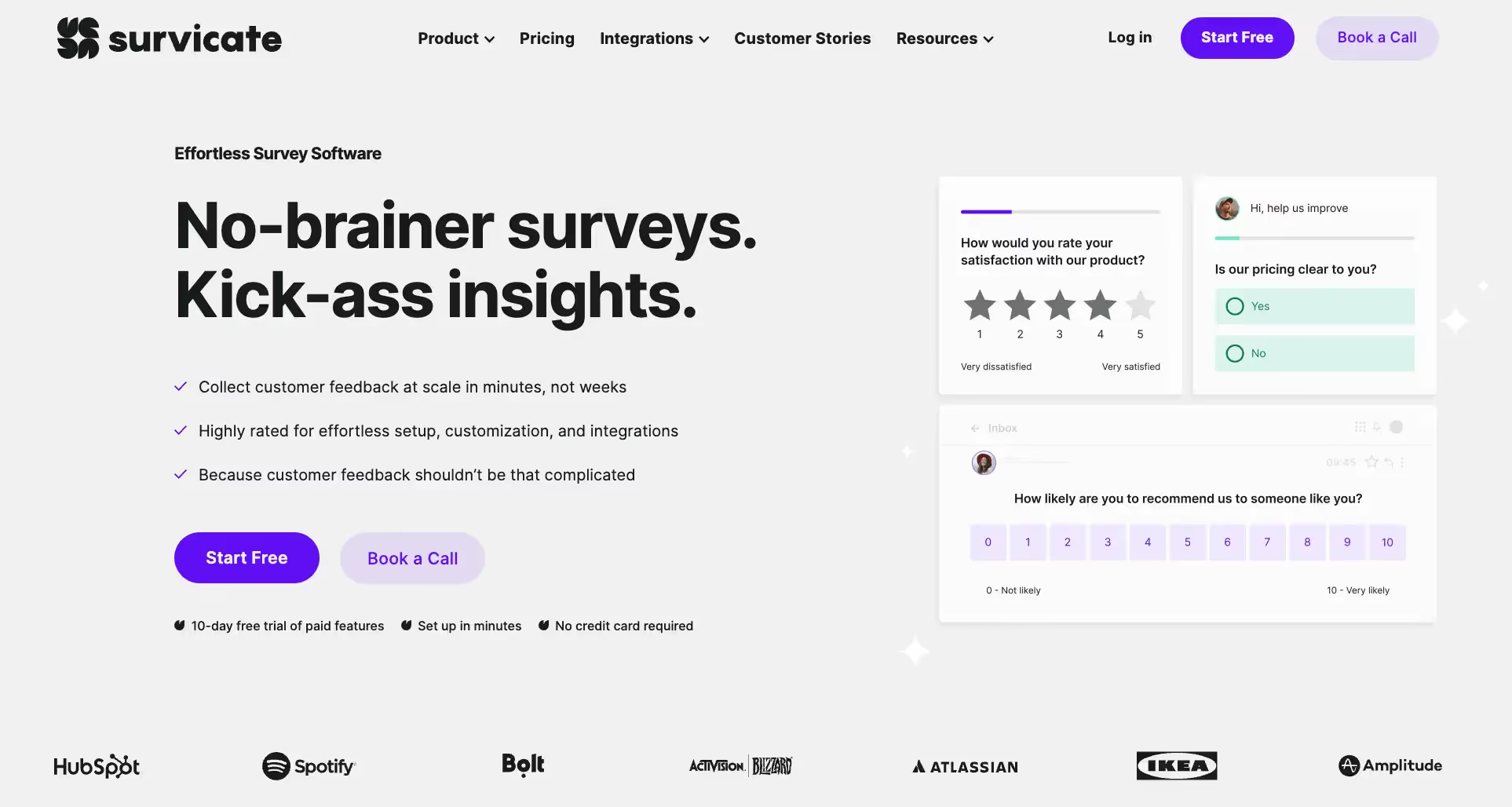
Survicate offers you an intuitive user interface and the ability to collect feedback across various channels. Real-time analytics and customizable surveys are standout features that can help you make informed decisions quickly.
Top features:
- Multichannel surveys
- AI survey creation and analysis
- Advanced filtering
- Around 30 integrations with CRMs, Product analytics, communication platforms and other third-party tools
- Feedback Hub
Survicate will be a top choice if you aim to collect contextual insights from your website visitors, product users and potential customers. This tool enables you to create a personalized survey experience, which can boost response rates.
Apart from a great user experience, you will be able to combine your survey data with other sources to get a more comprehensive view.
Canny
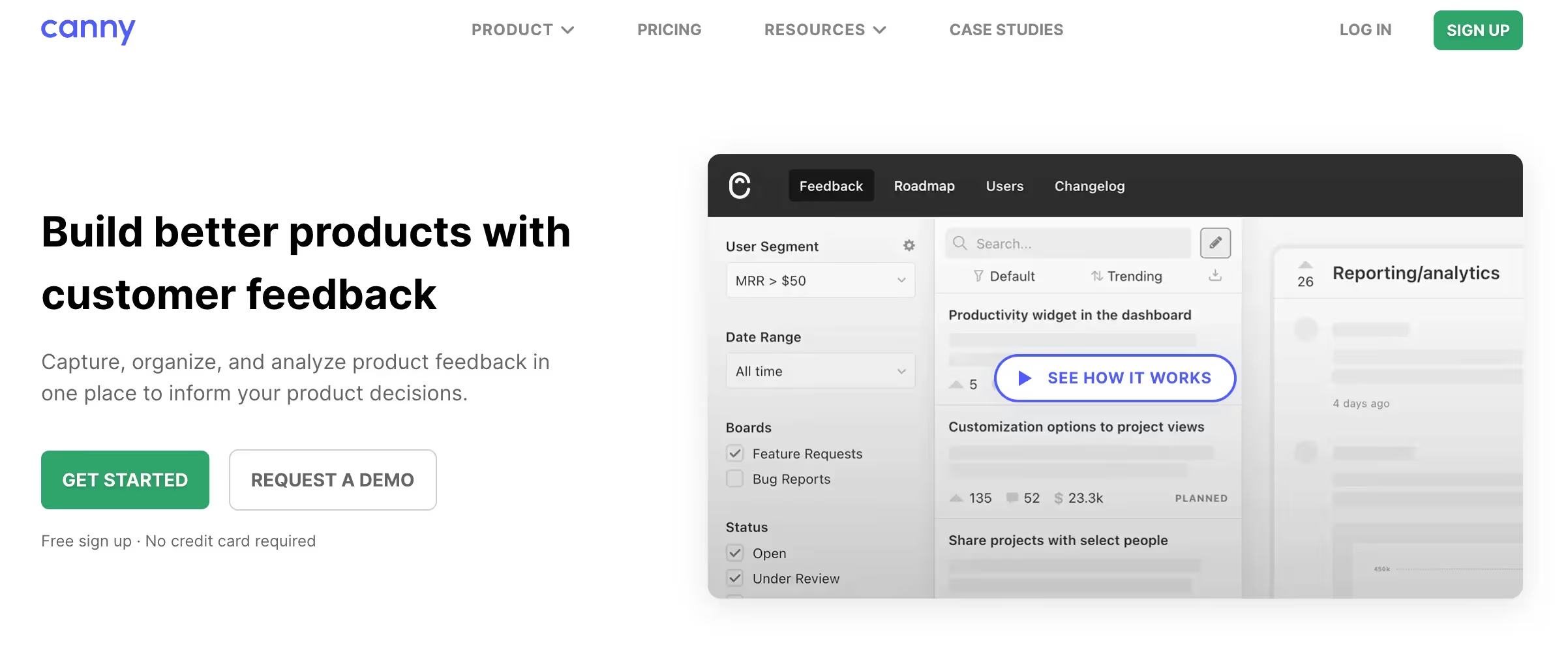
Canny is a feedback tool tailored for product managers. It's useful for tracking user requests and feature voting, fostering a community around your product. A key aspect of Canny is its roadmap feature, which keeps your users informed about future updates.
Top features:
- Organizing customer feedback
- Feedback segmentation
- Integrations with project management and communication platforms
- Public roadmap
Canny makes collecting customer feedback more efficient by helping with its prioritization and management. However, you might need an additional platform to run targeted and personalized surveys.
Savio
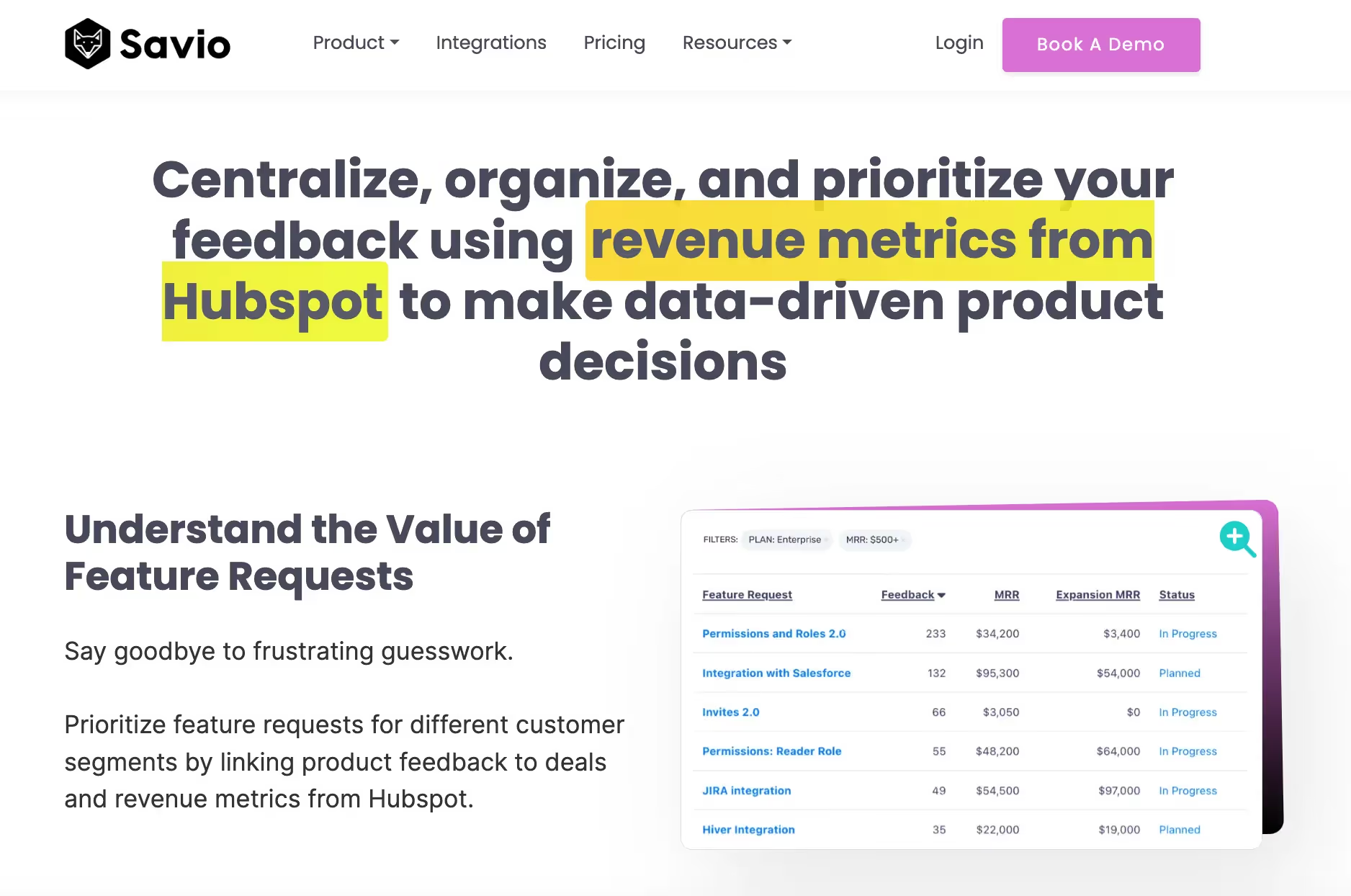
Savio is designed to centralize feedback from multiple platforms into one place. It simplifies the process of prioritizing features, ideal for software teams who want to stay user-centric. Savio is capable of segmenting feedback to focus on the most valuable users.
Top features:
- Centralized product feedback
- Categorization of feature requests
- Sync with Dev tools such as Jira or Shortcut
- Voting boards
This product management platform will support your product prioritization, but similarly to canny–you might want to need an additional survey tool to run targeted research. Luckily, there are plenty of solutions on the market that you can use.
UserVoice
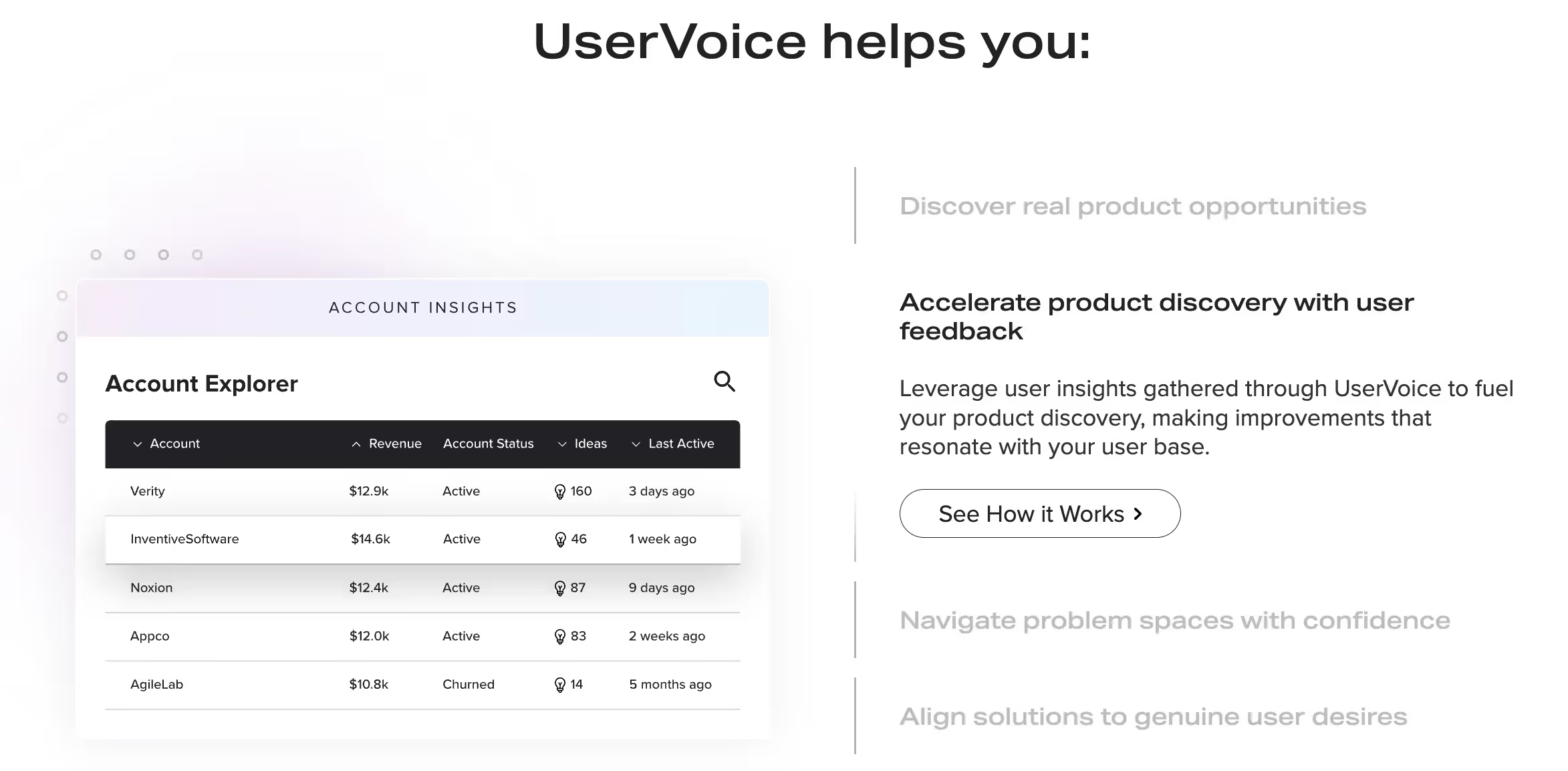
UserVoice is a comprehensive platform that offers a full suite of feedback management features. You can employ it to gather and analyze user feedback and turn insights into action. UserVoice is known for its analytics tool that helps in understanding user trends.
Top features:
- In-app widgets
- Kanban boards
- Sentiment analysis of customer feedback
- Public statuses
When you opt-in for UserVoice, you must be prepared for its high cost. The pricing starts from $699 for 200 users and grows accordignly.
Medallia

Emphasizing the enterprise market, Medallia excels in customer experience management. It captures feedback across all touchpoints and provides advanced analytics. With Medallia, you gain access to real-time insights which can be leveraged to improve customer satisfaction.
Top features:
- Website feedback and in-product surveys
- AI text analysis
- Complex reporting and analysis
- Contact centre
Medallia can support you when it comes to customer feedback data, although it's a very complex and robust tool. Might be a better fit for enterprises that won't have the problem with involving a technical team during onboarding. This software is also associated with high costs.
For teams looking for more intuitive onboarding and implementation, effortless user experience and cheaper options–we recommend checking out the alternatives, such as Survicate.
Kraftful
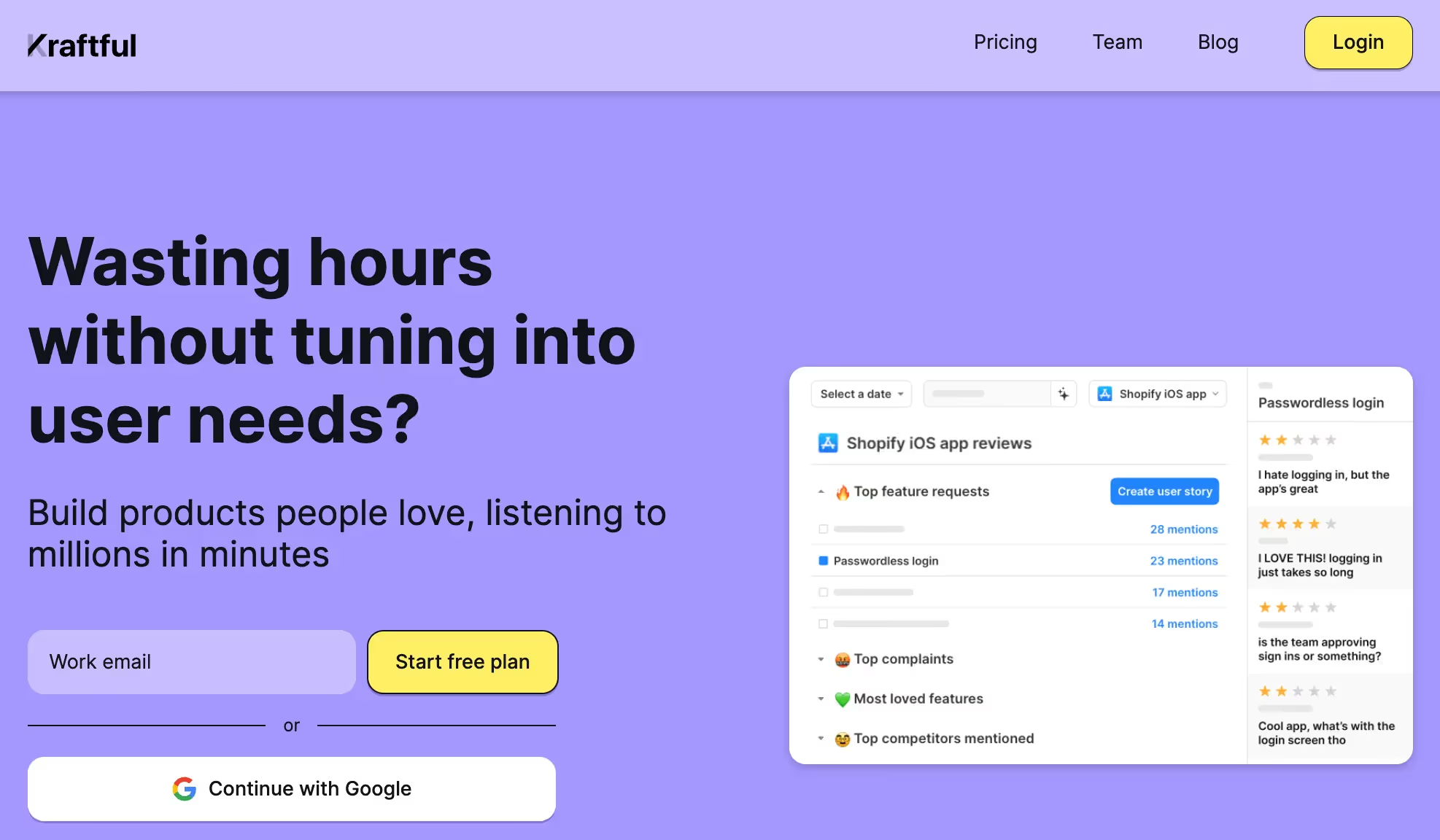
Kraftful is a modern user feedback tool with a free trial. It helps in understanding how users interact with your software and provides insights to improve the user experience.
Kraftful's strength lies in its ability to analyze customer feedback from different sources. You can get actionable insights
Top features:
- Link surveys
- AI-powered analysis
- Custom reports
- App Store sync and analysis
Kraftful might be a useful tool to make data-driven decisions in product management. It can partially automate your research and offer AI support. However, if you're looking for a solution with advanced customer feedback capabilities, you might be disappointed with surveys–those are limited by channels, design capabilities and targeting options.
How to implement a feedback management system
Implementing a feedback management system effectively hinges on careful planning, seamless integration, and comprehensive training and support.
Planning and strategy
To begin, assess your goals for feedback collection and analysis. Establish clear objectives such as improving product features, customer service, or user experience. You'll need to determine the metrics that will indicate the success of the feedback management system in meeting these objectives.
- Identify Stakeholders: List out all parties involved in feedback management, from leadership to customer-facing employees.
- Set Timelines: Establish a realistic timeline for each phase of implementation, including milestones for progress evaluation.
- Resource Allocation: Ensure adequate resources are assigned, including budget, personnel, and tools.
Integration with existing systems
Your Feedback Management System should integrate seamlessly with your current infrastructure to maintain data continuity and efficiency.
- API utilization: Check if the system offers an API for integration with your existing customer relationship management (CRM) or helpdesk software.
- Data migration: Plan for a secure transfer of existing feedback and customer data into the new system.
- Workflow mapping: Align the feedback management workflows with your current business processes to avoid any disruptions.
Training and support
It is crucial to equip your team with the necessary skills and knowledge to use the new system effectively.
Comprehensive training: Schedule training sessions for all users to cover the system’s features and best practices for handling feedback.
Content: Include manuals, video tutorials, and live demonstrations in your training content.
Ongoing Support: Set up a support structure with quick access to helpdesk or technical support for addressing any issues that may arise.some text
Feedback loop: Encourage users to provide feedback on the system itself to continually refine and improve the training and support provided. Close the feedback loop by letting them know how you acted upon their feedback.
Real-life use cases of feedback management
In this section, you will explore real-world applications and wise strategies for leveraging feedback management tools effectively.
Industry-specific use cases
- Healthcare: A healthcare app can implement a feedback management system to collect user experiences after they use a service. This allows for real-time responses to concerns, leading to improved patient satisfaction scores and identifying bottlenecks and areas for improvement.
- E-commerce: An online retailer can use user feedback management tools to track customer opinions on products. This can influence improvements in the checkout experience, encourage more customers to come back and reduce the number of abandoned carts.
- Education: A university can adopt a feedback management tool to gather student input on courses. The insights will modify curriculums and result in higher student satisfaction.
Common pitfalls in feedback management
- Ignoring negative feedback: Companies sometimes focus solely on positive comments, missing critical insights found in negative feedback that could drive essential improvements.
- Over-surveying users: Flooding users with too many feedback requests can lead to survey fatigue, thereby reducing the quality and quantity of the responses.

Manage customer feedback effortlessly with Survicate
Saved time, real-time notifications and easier access to insights and conclusions are just a few of the benefits of feedback management tools. For busy product managers, tools like that can make a major difference. Imagine understanding user behavior in seconds thanks to AI instead of reading through all text responses and reviews for hours. Sounds right?
Then you might want to kick off with your Survicate's free trial. Multichannel surveys, AI response analysis, and a comprehensive Feedback Hub are just a few clicks away!








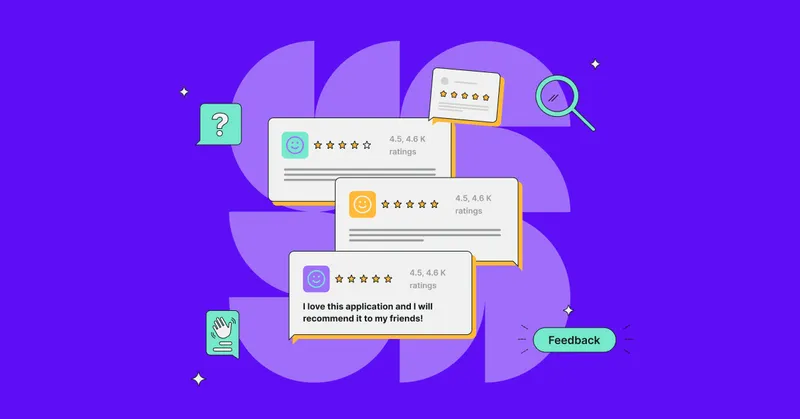
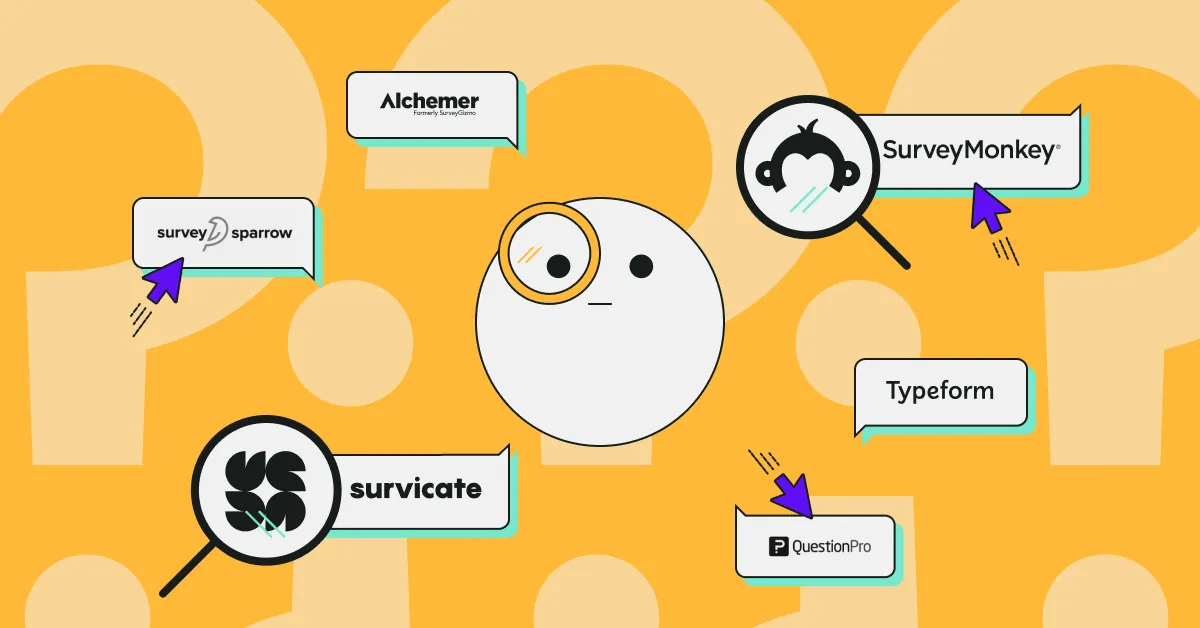

.png)



.svg)

.svg)



